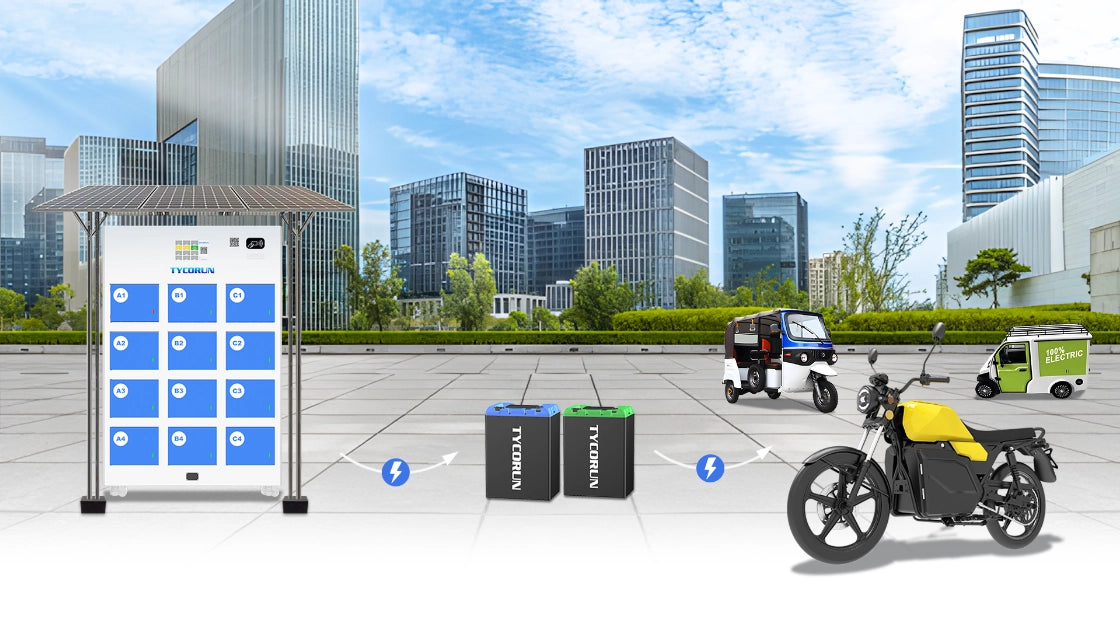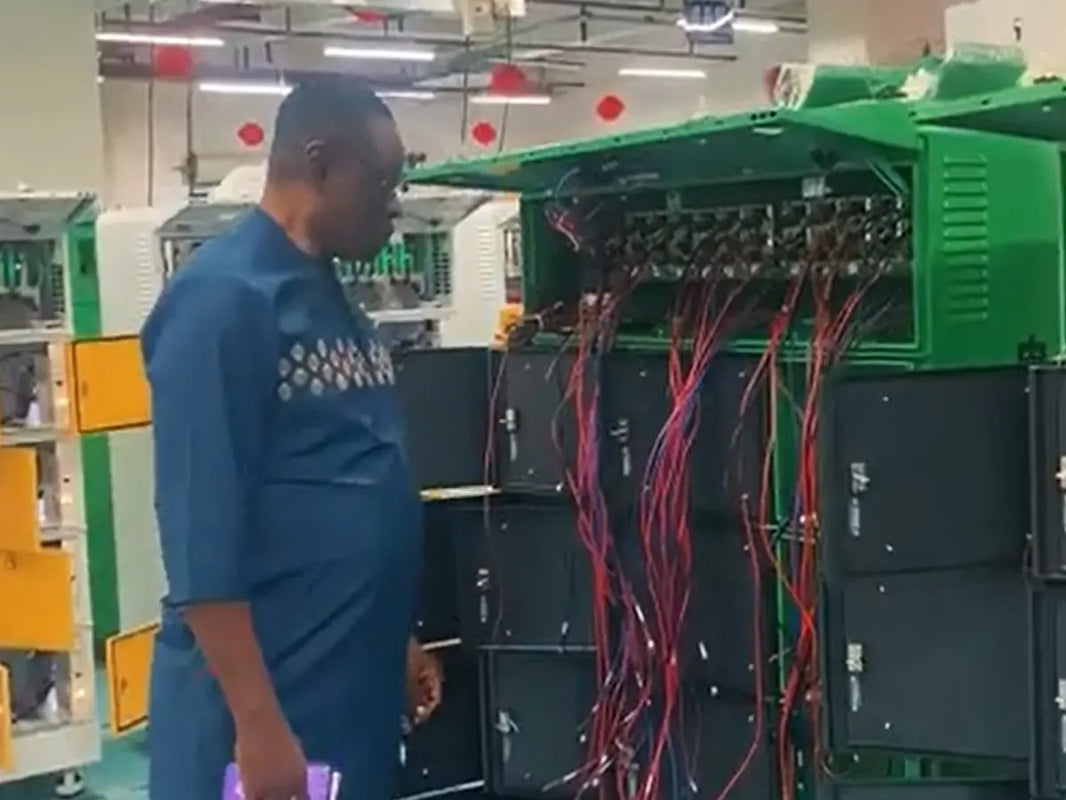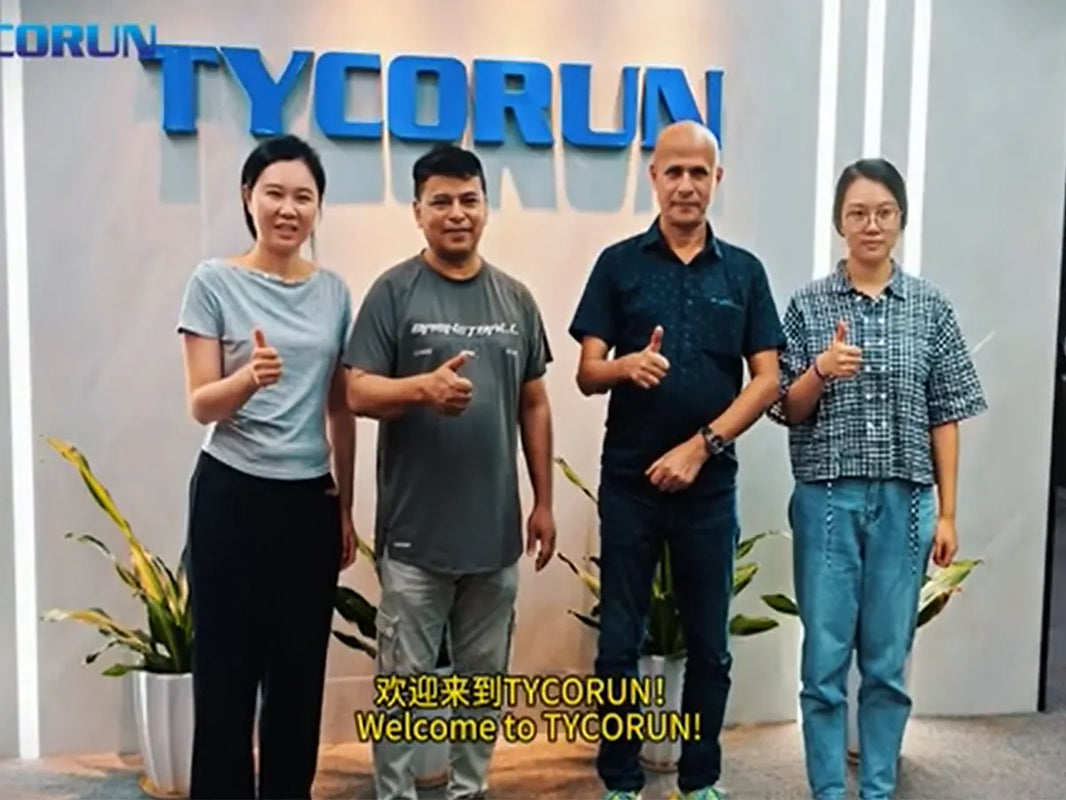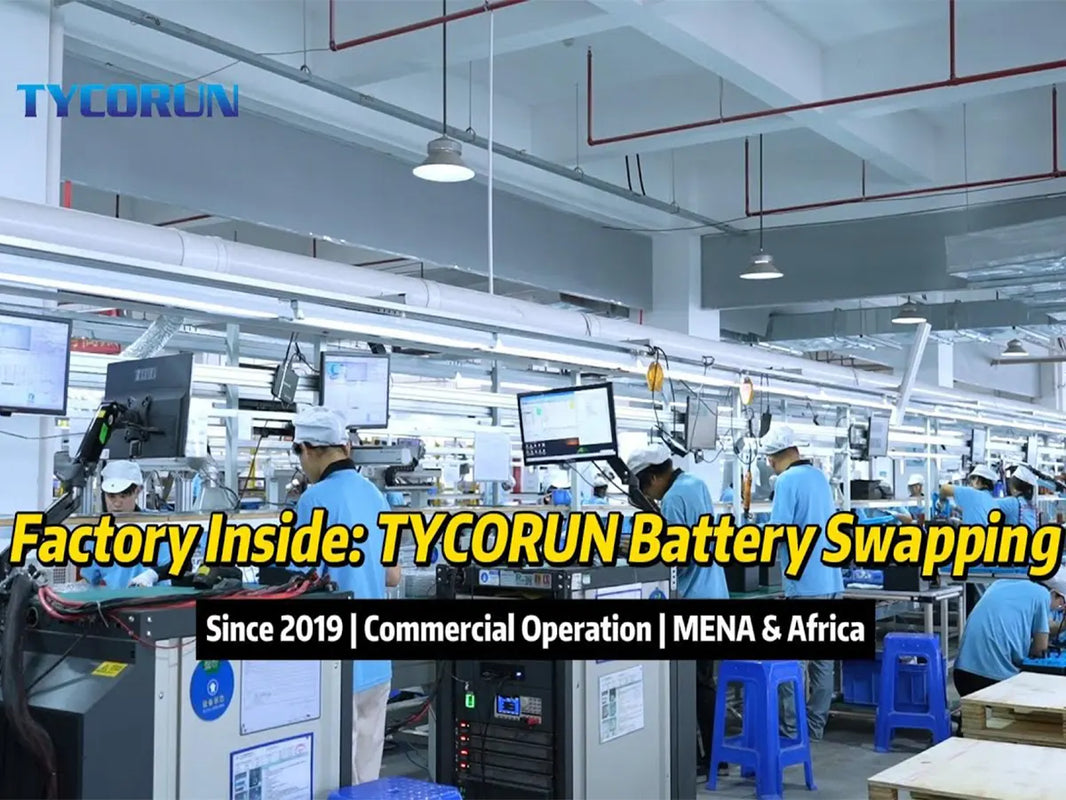
Main content:
- Electrochemical energy storage has great potential, and battery thermal management solves safety problems
- Electrochemical energy storage is expected to grow
- Thermal management is an important part of electrochemical energy storage systems
- Energy storage battery thermal management has become the core, and liquid cooling technology has developed rapidly
- Air-cooling technology: air-conditioning refrigeration, air duct exchange heat
- Liquid cooling technology: higher cooling efficiency
- It is estimated that the market space in 2025 will be 12.3-23.7 billion RMB
- There are many competitors, and the competitiveness is reflected in the comprehensive cost
- Temperature control and automotive thermal management companies participate in the industry
- Energy storage liquid cooling and power battery thermal management pay more attention to economy
- Temperature uniformity and energy consumption are more important for battery thermal management systems
- Enterprise competitiveness is reflected in efficiency and comprehensive cost
1.Electrochemical energy storage has great potential, and battery thermal management solves safety problems
This article will tell you all the details about the special report on energy storage battery thermal management industry.
① Electrochemical energy storage is expected to grow
Carbon peaking and carbon neutrality goals drive the rapid development of clean energy. In the context of carbon neutrality, the installed capacity of wind and solar clean energy will grow rapidly. The lithium ion solar battery is widely used to make full use of solar energy. In 2021, China's photovoltaic installed capacity will still reach 52.97GW, a year-on-year increase of 7.8%. The annual installed capacity of wind power reached 47.57GW, which was -40.9% year-on-year in 2020, but +183.3% year-on-year in 2019. In the medium and long term, according to relevant documents issued by the Chinese government, the proportion of wind and solar power generation will increase to 16.5% by 2025.
And the national installed capacity of wind and solar power will exceed 1,200GW in 2030. It is estimated that by 2030, the proportion of non-fossil energy consumption in China will reach about 26%. The installed capacity of energy storage has increased rapidly. With the gradual increase in the proportion of clean energy, energy storage plays a crucial role in the power generation side, grid side and user side of the power system, mainly pumped hydro energy storage and electrochemical energy storage.
According to data, in 2021, the installed capacity of newly commissioned power storage projects in the world will be 18.3GW, a year-on-year increase of 185%. Among them, the cumulative installed capacity of power storage projects that have been put into operation in China reached 35.7GW, a year-on-year increase of 9.80%. It is estimated that by 2030, the installed capacity of energy storage in the world will reach 741GWh, and the installed capacity of energy storage in China will reach 153GWh. There is huge room for market growth in the future.
Electrochemical energy storage has unique advantages. Since 2021, relevant energy storage policies for supporting existing centralized wind and solar power plants have been issued frequently. Considering the natural environment, response speed, long-term economy, etc., electrochemical energy storage has gradually become the main solution. The advantages of electrochemical energy storage include high energy density, flexible application, and fast response. In terms of battery types, lithium iron phosphate is more cost-effective in the short term, and sodium batteries are also expected to occupy a certain share in the long term.
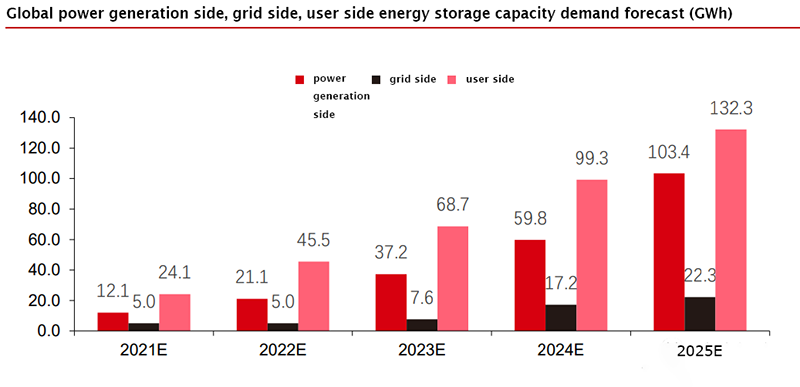
The global installed capacity of electrochemical energy storage has accelerated in the past two years. According to the data, from 2015 to 2017, the global electrochemical energy storage industry grew slowly, and the annual newly installed capacity was less than 1GW. Since 2018, the scale of newly installed capacity in the global electrochemical energy storage market has been enlarged. In 2021, the newly installed capacity will reach 10.2GW, and the cumulative installed capacity will reach 24.4GW, an increase of 117% and 71.8% year-on-year respectively.
It is conservatively estimated that the global energy storage market is expected to approach the storage capacity demand of 260GWh in 2025. It is conservatively estimated that the global energy storage market is expected to generate 41.2/71.7/113.5/176.4/258.0GWh of energy storage capacity requirements in 2021-2025, corresponding to a CAGR of +37.7% in 2022-2025, and the energy storage industry chain will usher in explosive growth. It is estimated that the demand for energy storage on the power generation side in 2021-2025 will be 12.1/21.1/37.2/59.8/103.4GWh, corresponding to CAGR+48.7%. The energy storage demand on the grid side is 5.0/5.0/7.6/17.2/22.3GWh, corresponding to CAGR+45.1%. The energy storage demand on the user side is 24.1/45.5/68.7/99.3/132.3GWh, corresponding to a CAGR+30.6%.
② Thermal management is an important part of electrochemical energy storage systems
The electrochemical energy storage industry chain is divided into three parts: upstream equipment vendors, midstream integrators, and downstream applications. Upstream equipment includes battery packs, energy storage converters (PCS), battery management systems (BMS), energy management systems (EMS), battery thermal management and other equipment, and most practitioners extend from other similar fields. The core of the midstream link is system integration + EPC. The downstream is mainly divided into four scenarios: power generation end, grid end, household/commercial end, and communication. Most companies in the energy storage industry chain participate in 1-2 sub-fields, and a few companies participate in everything from battery to system integration, and even EPC.
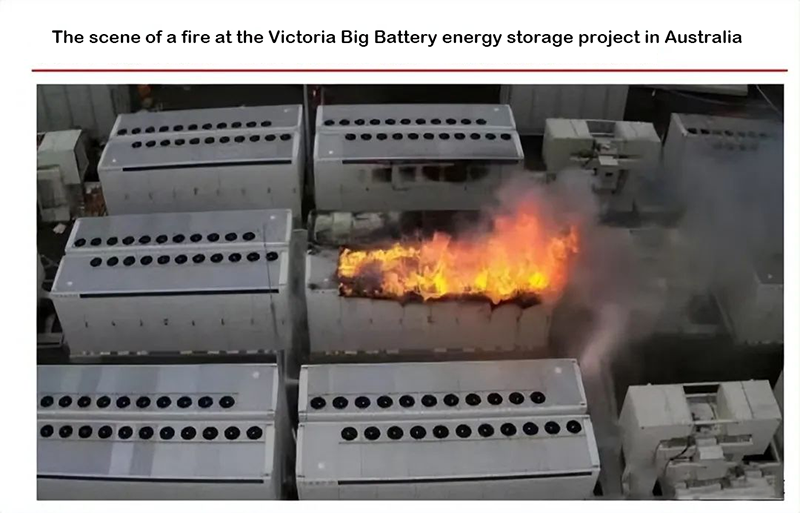
The battery pack is the most important part of the energy storage system, and lithium and sodium batteries have great potential. Different types of batteries have differences in energy density, power density, cost, safety, etc. According to calculations, from the perspective of the whole life cycle, the initial investment cost of lithium-ion batteries, lead-acid batteries and flow batteries is comparable, but considering the later maintenance, lithium-ion batteries show obvious cost advantages. Currently, the sodium-sulfur battery has not yet formed a mature industrial chain, but it is expected to become a low-cost technology category.
Energy storage system safety incidents highlight the importance of battery thermal management. On April 16, 2021, a fire and explosion occurred at the GOTION OFFSHORE FULL-SERVICE storage power station. After investigation, the cause of the fire was an internal short circuit in the LFP battery, which caused the battery to run out of control and catch fire.In July of the same year, the large battery project in Victoria, Australia, equipped with Tesla's Megapack energy storage system, leaked during the test due to the cooling system, which caused a fire in the battery compartment. The frequent occurrence of fire incidents highlights that battery thermal management has become an essential and important component to ensure the safe operation of energy storage power plants.
2. Energy storage thermal management has become the core, and liquid cooling technology has developed rapidly
Thermal management has become the core of the energy storage system, and air cooling and liquid cooling are currently mature technology routes. The cooling methods of energy storage battery thermal management mainly include the following three technical routes: air cooling (air cooling), liquid cooling and phase change cooling. At present, China's energy storage system battery thermal management routes basically use forced air cooling, and foreign countries have already applied liquid cooling for heat dissipation.
There are also many engineers working on phase-change materials and liquid-cooled or air-cooled hybrid models, but they are not yet mature. The core difference between air cooling and liquid cooling is the difference in heat transfer medium. Specifically, the heat transfer efficiency of the liquid medium is the highest, which can reach 0.5-10. The heat transfer efficiency of the air medium is generally around a few tenths, from the heat transfer coefficient, the air medium is lower (25-100), and the liquid medium is higher (1000-15000).
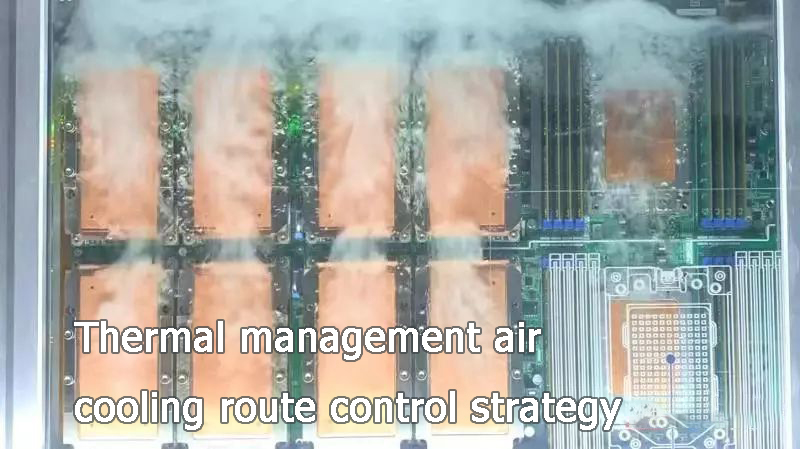
The air-cooled system is simple and low-cost, and the liquid-cooled power consumption is lower and the effect is better. The air cooling system has the characteristics of simple system, low manufacturing cost and easy installation. There are many applications in scenarios where the battery energy density is low and the charging and discharging speed is slow. Liquid cooling has the characteristics of large heat carrying capacity and high heat exchange efficiency.
It is widely used in occasions where the battery pack has high energy density, fast charging and discharging speed, and large changes in ambient temperature. The liquid cooling system can be highly integrated with the battery pack, requiring little space, and there is no need to worry about dust and moisture condensation. However, the cost of liquid cooling technology is relatively high. If the installed capacity is large (above 5MWh), the cost of liquid cooling will be greatly reduced.
① Air-cooling technology: air-conditioning refrigeration, air duct exchange heat
The core of air cooling is air conditioning and air ducts. At present, air-cooled technology is mainly used in container energy storage systems and communication base station energy storage systems with low power density. On the one hand, the air-cooled system is simple in structure, safe and reliable, and easy to implement. On the other hand, because the energy density and space constraints of the energy storage system are not as severe as that of the power battery system, a lower energy can be obtained by increasing the number of batteries.
Working rate and heat generation rate. Taking the containerized lithium battery energy storage system as an example, the system consists of standard containers, lithium ion battery systems, BMS for lithium ion battery, energy storage converters, air conditioners and air ducts, power distribution cabinets, and heptafluoropropane fire extinguishing devices. Air duct structure design: the air duct includes the main air duct connected to the air conditioner outlet, the air baffles in the main air duct, the air duct outlet and the air baffles at both ends of the battery rack.
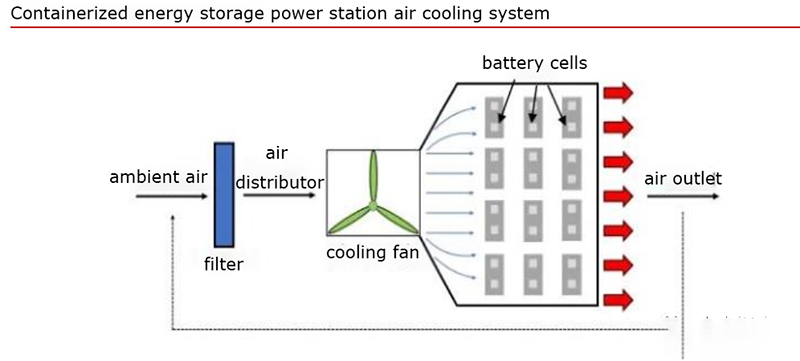
After the air conditioner outputs down through the air duct outlet at a certain speed, the fan on the front panel of the battery module enters the battery module through the air inlet on the rear panel of the battery module, flows through the surface of the battery to cool down the battery, and then the fan takes out the air. The rear panel of the battery module has holes to facilitate the air output from the air conditioner to enter the module; the front panel is designed with an axial flow fan to extract the air and promote the flow of air inside the battery module.
The airflow enters the interior of the battery module and flows through the surface of the battery cell, exchanges heat and cold with the battery cell, and is discharged by the fan to complete the cooling of the battery cell. Thermal management control strategies - air conditioning control and battery module fan control. The air-conditioning control is realized by the logic control of the air-conditioning itself. According to the different temperature conditions inside the container, it can be divided into heating mode and cooling mode.
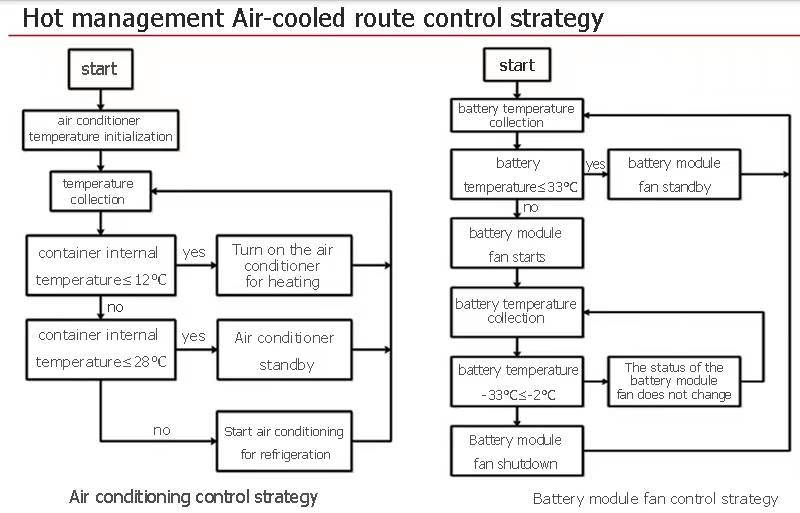
The battery module fans are controlled by the battery management system, and the fans of each battery module can be independently controlled to run.There are many different structural design schemes for the air-cooled heat management system. The air-conditioning structure includes floor-integrated, overhead-integrated, and split-type configurations; the air supply methods include top air supply, back air supply, and bottom air supply. Floor-mounted integrated air conditioners are used in energy storage containers that have reserved air conditioning space.
Usually, the top of the air outlet is connected to the air duct inside the container to directly supply air to the battery pack. However, if there is no space to install an air conditioner inside the energy storage container, an overhead integrated air conditioner needs to be used. The air conditioner is installed on the top of the container to cool the battery from the top. The split-type air conditioner internal unit is installed in the battery pack, and the front air is returned to the back to supply air, and the air outlet of the air conditioner is connected to the air duct to directly cool the battery.
② Liquid cooling technology: higher cooling efficiency
The liquid cooling scheme has significant comprehensive advantages in ensuring the safety of the energy storage system and the heat dissipation efficiency. The liquid cooling scheme uses cooling liquids such as water, ethanol, and silicone oil, and dissipates heat through indirect contact between the evenly distributed diversion grooves on the liquid cooling plate and the cells.
Its advantages include: 1) Close to the heat source, efficient cooling; 2) Compared with the container air cooling solution of the same capacity, the liquid cooling system does not need to design air ducts, saving more than 50% of the floor space, and is more suitable for the future of more than 100 MW. Large-scale energy storage power station; 3) Compared with the air-cooled system, the failure rate is lower due to the reduction of the use of mechanical components such as fans; 4) The liquid cooling has low noise, saves the self-consumption of the system, and is environmentally friendly.

The core of the liquid cooling system is the chiller and the liquid cooling plate. The chiller includes components such as compressors, condensers, throttles, evaporators and water pumps, and chiller manufacturers include Envicool, Tongfei, etc. Liquid cold plate is to process upstream raw materials such as copper and aluminum into corresponding plates. The production process of liquid cold plate is divided into brazing, inflation, die casting, stamping, friction stir welding, etc. Liquid cold plate manufacturers include YINLUN CO.,LTD, SANHUA, FRD, COTRAN, etc.
Safety and economy Two-wheel drive, battery thermal management technology to liquid cooling. The cooling structure involved in air cooling is simple, easy to install, and low in cost, but the cooling effect is low, accurate temperature control cannot be achieved, and a large area of heat dissipation channels is required. For projects with relatively low power density such as communication base stations and small ground power stations that are currently installed in the industry, the air-cooled cooling efficiency can be satisfied. Liquid cooling uses coolant convection to exchange heat, and the heat dissipation is more efficient and uniform, and the reliability is better.
In the future, as the demand for energy storage stations with larger battery capacity and higher system power density such as new energy power stations and off-grid energy storage starts, the energy density and calorific value of energy storage systems will be higher, and the requirements for safety and life will be higher. It will drive the industry to turn more to liquid cooling solutions. Leading companies such as CATL, SUNGROW, and BYD have taken the lead in switching, and the leading demonstration effect will drive the acceleration of liquid cooling penetration.
③ It is estimated that the market space in 2025 will be 12.3-23.7 billion RMB
Taking a 1MWh containerized energy storage system as an example, such small-scale and low-energy-density energy storage systems generally use air-cooled technology. According to our calculations, when the typical operating condition is 1C, the heat generation rate of the system is 39kW, and the required minimum cooling power of the air conditioner is 24kW. Taking an outdoor air conditioner on the market as an example, the cooling capacity is 1500W, the price is 2000 RMB/unit, and the cooling cost is calculated as about 1.33 RMB/W.
If the above-mentioned container energy storage system is satisfied, the corresponding cost is about 30,000 RMB, and it can be further concluded that the investment cost of choosing an air-cooled solution for a single GWh energy storage system is about 30 million RMB. Similarly, according to the cost of key components such as liquid cooling plates, the investment cost of choosing a liquid cooling solution for a single GWh energy storage system is about 90 million RMB. Assume that in the next 5 years, under the effect of technology progress and scale expansion, the cost of the two technology routes will decrease by 2% and 3% per year, respectively.
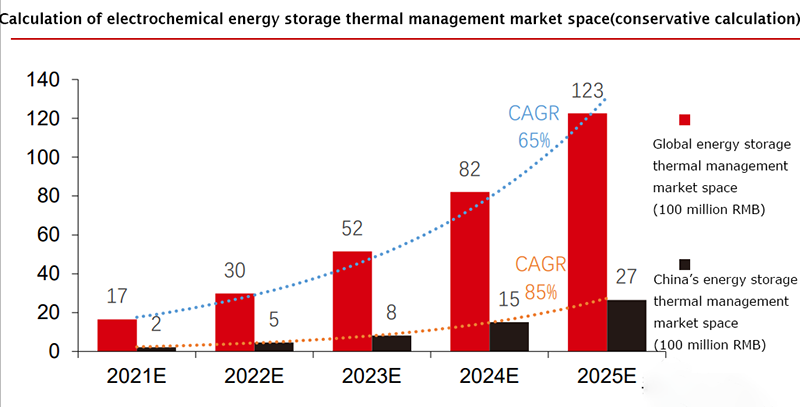
At the same time, it is assumed that the penetration rate of the liquid cooling scheme in 5 years is 20%/25%/35%/40%/45%, respectively. It is conservatively assumed that the global electrochemical energy storage capacity demand from 2021 to 2025 is 37/65/102/159/232GWh, and China's energy storage capacity demand is 5/10/16/29/50GWh, respectively. The calculation results show that under conservative assumptions, the global electrochemical energy storage battery thermal management market space in 2021-2025 will reach 17/30/52/82/12.3 billion RMB, corresponding to CAGR+65%.
Among them, the Chinese market will reach 2/5/8/15/2.7 billion RMB, corresponding to CAGR+85%. Under the neutral assumption, if the global demand for electrochemical energy storage capacity reaches 315GWh in 2025, the corresponding energy storage battery thermal management market space will be 16.6 billion RMB, and the CAGR from 2021 to 2025 will be 78%. Under the optimistic assumption, if the global demand for electrochemical energy storage capacity reaches 450GWh in 2025, the energy storage battery thermal management market space will be 23.7 billion RMB, and the CAGR from 2021 to 2025 will be 95%.
3. There are many competitors, and the competitiveness is reflected in the comprehensive cost
① Temperature control and automotive thermal management companies participate in the industry
Participants in the energy storage battery thermal management industry are divided into two categories according to the source of technical routes. The first category is air-cooling technology, most of which are air-conditioning-related companies in the past, including precision temperature control (such as Envicool, SHENLING, longertek), automotive air-conditioning thermal managers (SONGZ, Aotecar, SANHUA, YINLUN Co., Ltd.)
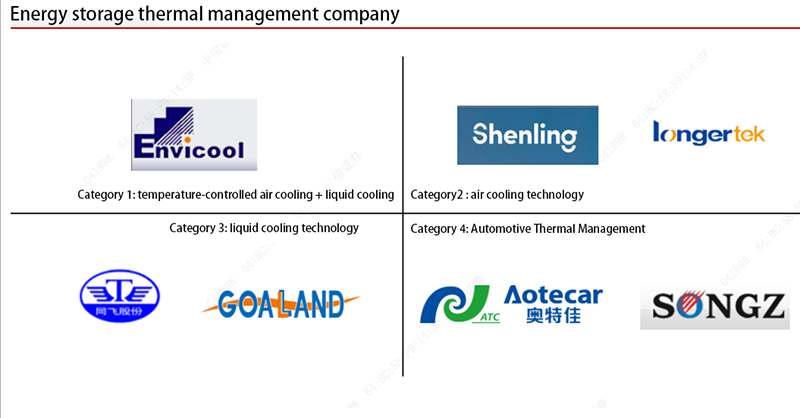
The second category is companies with liquid cooling technology.The previous business was related to industrial cooling, such as Tongfeii and Goaland. New energy companies can obtain better performance by virtue of the integrated design of energy storage batteries and battery thermal management systems, and stabilize the battery thermal management system market by virtue of the market share of batteries. On the other hand, temperature control equipment companies have deeper technological accumulation and scale advantages, and may gain advantages in cost and industry standards.
② Energy storage liquid cooling and power battery thermal management pay more attention to economy
Energy storage batteries and power battery systems have differences in application scenarios, performance, and lifespan. There is no significant difference between the two in terms of technical principles, but due to the difference in application scenarios and battery capacity, the requirements for the performance and service life of the two are also different:6 1) The power battery pursues higher energy density and charging speed, while the energy storage battery requires less energy density, but requires a higher number of cycles; 2) In terms of battery capacity, the energy storage system has a large capacity, which has a negative impact on battery consistency,
The system cost and service life requirements are higher, and the performance of the battery management system and energy management system is more tested. Under the premise of the same ten-year life, assuming that the power battery is fully charged and discharged once every three days, and considering that the theoretical life of the ternary lithium iron phosphate battery pack is 1200 times, the life of the ternary lithium iron phosphate battery pack is about ten years. Energy storage batteries are charged and discharged more frequently, and have higher requirements for cycle life, requiring more than 3,000 cycles.
There are also large differences in system structure and cost. The complete electrochemical energy storage system is mainly composed of battery pack, battery management system (BMS), energy management system (EMS), energy storage converter (PCS) and other electrical equipment. In the cost structure of the energy storage system, the battery is the most important component, and the battery thermal management value of a single GWh is about 30 million RMB/90 million RMB. In the battery thermal management of new energy vehicles, it is divided into air-conditioning and three-electric thermal management, and the value of a bicycle is about 4,500 RMB and 3,000 RMB respectively.
The battery thermal management of energy storage works continuously and requires high safety. Power batteries pursue higher energy density and charging speed, and at the same time, the vehicle needs to control the mass and volume, usually using a liquid cooling system. Energy storage batteries do not have high requirements on energy density, charging speed, quality and volume, but they usually need to work uninterruptedly and have a longer life.
The battery thermal management system is also required to have the ability to work stably for a long time and a life of more than ten years. As the energy storage cells are cycled more and the consistency varies between packs, there is a greater risk of thermal runaway. In addition, energy storage batteries have higher requirements for safety, and the loss and impact of safety accidents in densely populated sensitive areas such as buildings and supermarkets and in the field of backup power are unacceptable. Therefore, a more stable and safer battery thermal management system is required.
③ Temperature uniformity and energy consumption are more important for battery thermal management systems
Industrial air-conditioning refers to air-conditioning equipment that provides environmental temperature, humidity and cleanliness guarantees for the reliable operation of industrial production processes or industrial equipment. The main purpose of industrial air conditioners is to ensure process requirements. Generally, they are designed to operate 24 hours a day and throughout the year. They can be used for more than 15 years and can basically meet the requirements of energy storage systems. However, because the energy storage system is more sensitive to the energy use and temperature uniformity of the battery thermal management system, industrial air conditioners with energy consumption and safety advantages are more favored by energy storage air cooling.
④ Enterprise competitiveness is reflected in efficiency and comprehensive cost
Energy storage battery thermal management is characterized by a high degree of customization. According to the application scenarios, installed capacity, natural environment, cost and other comprehensive requirements of the energy storage system, each specific energy storage project has a relatively unique solution, such as air cooling/liquid cooling selection, air duct arrangement, air volume and uniformity, cleanliness, temperature control range, etc.
For instance, home energy storage is one of the important application scenarios. This requires enterprises to: 1) have the ability to formulate and implement efficient solutions in the face of many customers and different projects; 2) energy storage systems have high economic requirements, so battery thermal management companies must reduce overall costs.

